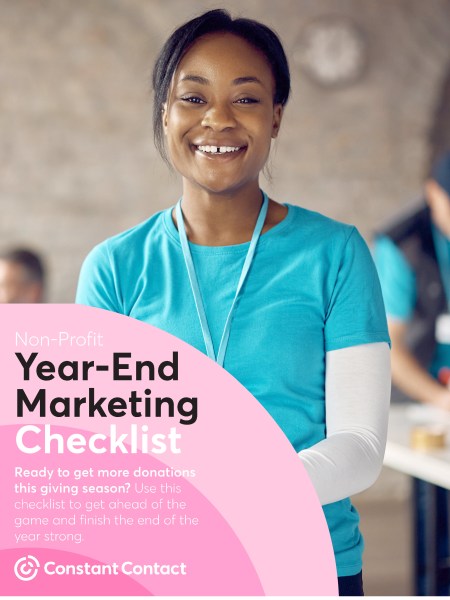
Countless worthy causes need support. Maybe you’re passionate about rescuing animals or helping children get school supplies. Or perhaps you’re ready to tackle climate change, poverty, and other significant challenges. No matter your cause, starting a nonprofit is a great way to make a difference.
Launching a nonprofit can be highly rewarding and impactful. These organizations address significant issues and strive to improve the lives of others. They also raise awareness and inspire more people to take up their causes. But it’s normal to feel intimidated if you don’t know how to start a nonprofit organization.
In many ways, founding a nonprofit is like starting a company. You’ll need the right strategy, marketing tools, and team to achieve your goals. This simple guide will help you turn your vision into reality and drive change.
Understanding nonprofits
A nonprofit is a tax-exempt organization that benefits the public and improves society. Unlike a business, a nonprofit doesn’t share its earnings with private individuals or shareholders. Instead, it invests all its resources into the organization to support the cause.
The Internal Revenue Service (IRS) oversees nonprofits in the U.S. Section 501(c)(3) of the Internal Revenue Code outlines the legal requirements for these organizations. According to these rules, nonprofits must:
- Be operated for exempt purposes, such as advancing education or protecting human rights
- Not take substantial action to influence legislation
- Not distribute profits to shareholders
- Not campaign for political candidates
Nonprofits that qualify as 501(c)(3) organizations don’t have to pay taxes on donations and other income. Donors also receive tax deductions, incentivizing their support.
There are many types of nonprofit organizations, including:
- Animal shelters
- Grassroots organizations
- Humanitarian aid groups
- Museums
- Nonprofit hospitals
- Public colleges and universities
- Religious organizations
- Wildlife conservation groups
- Veterans organizations
- Youth mentoring programs
These groups serve diverse causes and communities. They play vital roles in addressing environmental and social issues worldwide.
Benefits of starting a nonprofit organization
Launching a nonprofit organization has many financial and social advantages.
Tax-exempt organizations can use the money they save to support their cause. For example, you could buy more supplies or expand your programs to reach more people. Donors can also receive tax deductions for their charitable contributions. This incentive may attract more supporters and help your organization grow.
Your nonprofit organization could also qualify for public and private grants. Grants.gov lists over 2,000 federal grants for various causes. Many private foundations also offer grants for nonprofits. This funding can support programs and projects related to your cause.
Starting a nonprofit organization also boosts your credibility. It proves you’re committed to your cause and willing to invest resources. This process also shows that you care about transparency and accountability. As a result, the public is more likely to view your organization as legitimate and worthy of support.
Potential challenges
While starting a nonprofit has many benefits, there are always obstacles to be aware of.
These organizations require significant energy, time, and other resources. You may need to work for many hours before you see an impact. You may find this effort fulfilling if you’re passionate about your cause.
Nonprofits also face fierce competition. Today, the U.S. has over 1.5 million nonprofit organizations. Many groups struggle to stand out in this crowded landscape and earn enough revenue. You can overcome this challenge by developing a unique brand and marketing strategy.
Preparing to start a nonprofit
If you’re interested in creating a nonprofit, you probably already have a few great causes in mind. Follow these steps to lay the groundwork for your organization.
Conduct a needs assessment
Start your nonprofit journey with a needs assessment. This tool helps you identify and measure the needs and goals of your target population. That way, you can fill gaps in existing services and create tailored programs.
A needs assessment involves these steps:
- Define the broad issue you want to solve, such as illiteracy or pollution
- Identify the group(s) you can best serve
- Collect data to determine how the issue affects your target population
- Research competitors and identify gaps in their services
This process can help you determine if there’s an actual need for your nonprofit. For example, say you want to create an organization that trains service dogs for veterans. A needs assessment may reveal that local veterans are in need of mental health counseling instead. You could identify a different target audience that wants service dogs or adapt your plan to meet the veterans’ needs.
Complete a market analysis
Every nonprofit organization needs financial support from donors. Conduct a market analysis to identify potential supporters and funding sources. This process involves gathering data to learn about your target market’s preferences.
For example, you can survey potential donors about their giving habits and charitable interests. You can also research public and private grants that align with your mission.
Research different nonprofit structures
There are several types of nonprofit organizations with different structures and purposes. Common structures include:
- Charitable organizations: These nonprofits serve public interests and don’t benefit their creators or shareholders. They include educational, public safety, and scientific organizations.
- Churches and religious organizations: These organizations are formed for religious purposes. They include churches, mosques, and other institutions that offer spiritual services.
- Private foundations: These organizations have a single, primary source of financial support such as a corporation or family. They typically provide grants to other charitable organizations instead of creating programs themselves.
- Political organizations: These groups aim to influence politics. The IRS considers certain political organizations subject to tax under IRC section 527, including political parties and campaign committees. However, some organizations may qualify for tax-exempt status if they focus on causes instead of supporting specific candidates.
The IRS provides more resources to learn about nonprofit structures and relevant regulations.
Building a solid foundation
Every nonprofit organization needs a strong identity and message. Focus on these three areas to set yourself up for success.
Create a compelling name
Choosing the right name for your organization is essential. An effective nonprofit name relates to the organization’s mission and goals. It should also be unique and short so potential donors can easily remember it.

For example, Feeding America is a hunger relief organization. Its concise name reflects its central purpose: feeding people in need. The word “America” also shows that the nonprofit operates across the U.S.
Develop a mission statement
A mission statement describes your nonprofit’s purpose and overarching strategy. Effective mission statements answer three questions:
- What is your main cause?
- How do you support or address your cause?
- Who do you serve?
Your mission statement should be clear and concise. Create one to two sentences that sum up your main goal and strategy.
Use mission statements from other nonprofits as inspiration. Here are three examples from well-known organizations:
- “The American Red Cross prevents and alleviates human suffering in the face of emergencies by mobilizing the power of volunteers and the generosity of donors.”
- “The mission of the Cystic Fibrosis Foundation is to cure cystic fibrosis [CF] and to provide all people with CF the opportunity to lead long, fulfilling lives by funding research and drug development, partnering with the CF community, and advancing high-quality, specialized care.”
- “The mission of The Nature Conservancy is to conserve the lands and waters on which all life depends.”
These examples use dynamic verbs to explain their purpose and inspire readers to join their causes.
Establish your brand and identity
A distinct brand identity will help your nonprofit stand out from the crowd. It also boosts your reputation and raises awareness of your cause.

Effective nonprofit branding strategies include:
- Creating an eye-catching logo that fits your mission and values
- Using consistent fonts, colors, and other visual elements
- Developing a brand personality that resonates with your audience
- Producing infographics and reports to highlight your impact
Developing a business plan
You won’t earn a profit from your charitable organizations, but you still need a business plan. This document outlines your purpose, goals, and key strategies. It’s a valuable tool to guide decision-making and communicate with stakeholders.
Follow these steps to create a solid business plan.
Chart out the executive summary, programs, and services
The executive summary introduces your organization. It should include:
- Mission statement
- Summary of what your organization is and why it was founded
- A description of your programs and services
- An overview of your target audience
- An outline of future plans
Develop a marketing plan
Once you have completed a marketing analysis, it’s time to develop a marketing plan for your business. Your assessment will have help you to identify your audience and determine how to reach them. Use this information to help you develop a strategy and inform the types of marketing content that will work best to encourage engagement, donation, and support.
Develop an impact plan
An impact plan explains how you’ll use your resources and programs to advance your cause. It also describes the outcomes you hope to achieve. This section can persuade donors to support your organization.
Legal formation and compliance
People often wonder, “How long does it take to start a nonprofit?” The answer depends on several factors.
Many nonprofits apply for tax-exempt status. The IRS estimates it takes around 100 hours to collect records for and prepare Form 1023. Once you submit this paperwork, you’ll need to wait several months for the IRS to process it.
Some organizations elect a board of directors. These members should include people with different areas of expertise related to your mission. They can create bylaws to govern the organization’s activities. This process can take a few weeks, depending on how many members you elect.
Fundraising and financial management
How much does it cost to start a nonprofit? The costs vary significantly but may include:
- Incorporation fee: Some states require charities to register and pay an incorporation fee.
- Tax-exemption status application fee: The IRS charges a $600 filing fee for large organizations that apply for tax exemption with Form 1023. Smaller nonprofits can apply with Form 1023-EZ, which costs $275.
- Attorney fees: Some nonprofits hire an attorney to help them understand and comply with regulations.
- Fundraising platforms: Many organizations use fundraising platforms to collect donations. These platforms typically charge processing fees.
You may wonder how to start generating funds for your cause and to keep your nonprofit organization at the center of positive change. Consider applying for grants, hosting fundraisers, and asking for donations via social media, email, and in your locality.
Building a nonprofit team
You can start a nonprofit by yourself if you want to take on all the responsibilities. But many organizations recruit teams of experts and volunteers to share the workload. This collective effort can help you expand your impact and offer more services.
Aspiring leaders often wonder how to start a collective nonprofit. These strategies can help you build an all-star team:
- Network with like-minded people at events related to your cause.
- Use social media to recruit volunteers.
- Hire experts for leadership and marketing roles.
- Collaborate with other organizations.
- Offer training for employees and volunteers.
Operational strategies
The right software can help you manage your operations. Constant Contact’s digital marketing tools help you create content and reach supporters. The platform also integrates with fundraising tools to make it easy to collect donations.
Additionally, Constant Contact offers customer relationship management software. Use this tool to manage leads and collect donor information.
Getting the word out
You can use many channels to promote your nonprofit and raise awareness of your cause. Here are a few popular marketing strategies:
- Start a blog about your cause and programs
- Send an email newsletter with updates about your organization
- Connect with supporters on social media
- Share testimonials from people you’ve helped
- Partner with an influencer
- Host community events and workshops
It helps to create a content calendar to coordinate your marketing efforts across channels.
Next steps and future planning
Starting a nonprofit is an exciting venture. To set yourself up for success, create a detailed road map. This plan helps you shape your organization’s future and achieve sustainable growth.
Once you’ve developed your plan, take the next step by joining fundraising movements. Campaigns like #GivingTuesday can help you connect with donors and promote your organization. You can also network with other nonprofit leaders and share valuable resources. These simple steps will allow you to maximize your impact and make a real difference.





